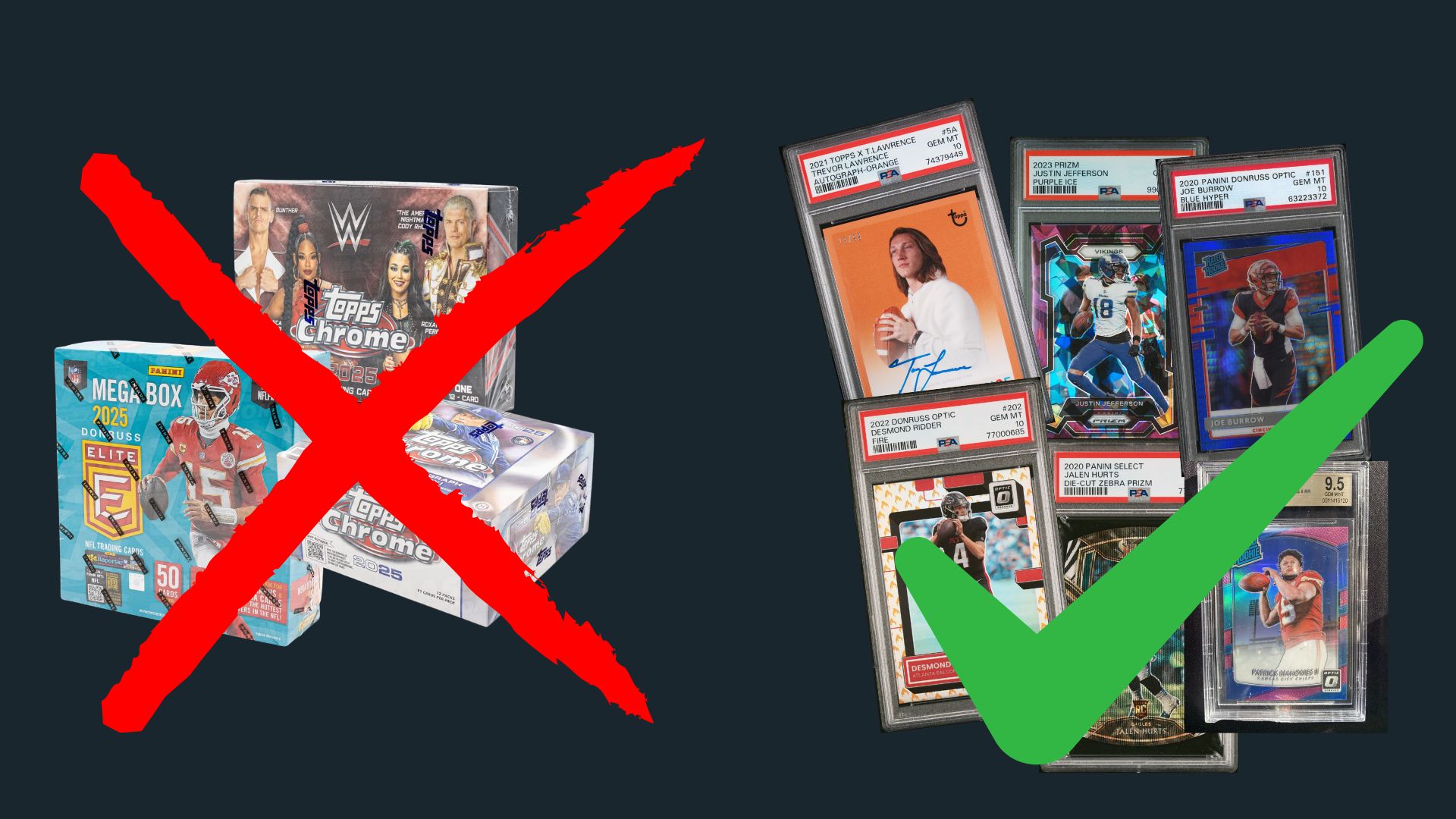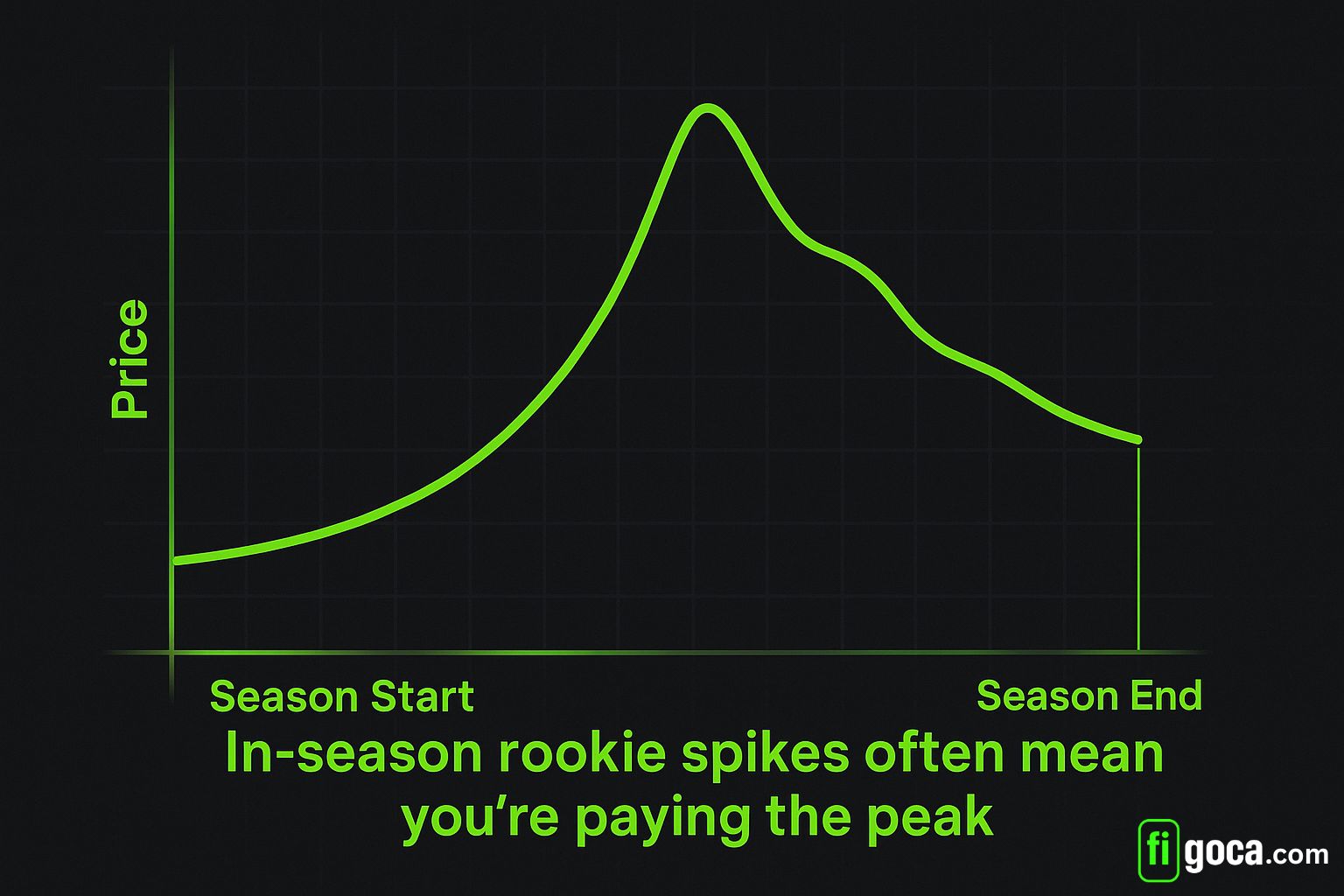
5 Sports Card Mistakes to Avoid in 2025
Sports cards are booming—but most won’t hold value. Avoid 5 costly mistakes, buy smarter with data, and get the free budget checklist today to save money.
5 Sports Card Mistakes to Avoid in 2025
The market is exploding again. Hard truth: most modern cards won’t hold value. This guide shows the traps new and returning collectors fall into—and smarter plays to save money, reduce stress, and actually enjoy the hobby.
TL;DR
- Buy with data, not hype. Use sold listings, not asks. Check population reports.
- In-season rookie spikes are expensive. Off-season or post-hype windows are usually better.
- Treat breaks as entertainment. Buy singles when you want certainty.
- Focus your lane (player, team, set). Avoid chasing every release.
- Track a simple budget. Fees, shipping, and grading kill margins fast.
figoca extension
Get card comps on eBay in seconds
See comps directly on eBay listings and search results. Save time, avoid overpaying, and learn faster while you browse.
- Comps inline on item and search pages
- Automatic card detection and parsing
- Fast, privacy-first, and free
- Built for newcomers and hobbyists
1) Buying Rookie Hype at the Peak
In-season performance and social buzz push rookie prices up quickly. Many spikes fade within weeks as the schedule normalizes, injuries happen, or depth charts change.
Why it hurts
- You pay a “hype premium” during debuts, hot streaks, or playoffs.
- Base and high-pop slabs flood the market after grading returns, capping upside.
Do this instead
- Wait for quieter windows (off-season, after an injury recovery, or post-elimination).
- Anchor to sold comps over 30–180 days; ignore outliers and asking prices.
- Prefer numbered parallels, on-card autos, or low-pop slabs of players you truly believe in.
Practical warning: If a chart looks like a straight line up due to one game, it can come straight back down just as fast.

2) Treating Breaks Like an Investment (They’re Entertainment)
Breaks are fun, social, and thrilling—exactly like entertainment. Expected value across sealed product plus breaker margins is usually negative for buyers.
Why it hurts
- Low odds of pulling a chase card; repeated entries compound losses.
- FOMO and instant reveals encourage overspending beyond plan.
Do this instead
- Set a strict entertainment budget (e.g., 10% of your monthly hobby spend) and stick to it.
- When you want certainty, buy the exact single after the product settles.
- If you join a break, choose formats you understand (PYT vs random teams) and price-check against singles.
Practical warning: Track every break entry for one month. Most collectors are surprised by the total.
3) Ignoring Supply: Pop Reports and Serial Numbers
High population means soft ceilings. A PSA 10 modern base card with thousands of copies competes with constant new supply.
Why it hurts
- Re-grading and re-listing keep supply flowing even when demand cools.
- Liquidity is fine, but prices can drift sideways or down as the novelty fades.
Do this instead
- Check population reports before you buy; note grade distribution and recent growth.
- Favor scarcity signals: serial-numbered parallels (/199, /99, /49, /25, /10, /5, 1/1), on-card autos, short prints.
- Prioritize eye appeal (centering, surfaces) even in slabs; it matters on resale.
Practical warning: A low-pop grade because nobody submits the card is not the same as true scarcity.
Tools
4) Chasing Every Release and Parallel
Modern checklists have deep parallel ladders and frequent releases. Without a plan, you’ll scatter your budget across cards you don’t truly want.
Why it hurts
- Hard to track value and progress; easy to impulse-buy.
- You end up with duplicates that don’t fit a cohesive collection.
Do this instead
- Pick a lane: player-focused, team-focused, specific set/parallel, or true RC autos.
- Pre-define 3–5 target cards with a max price per card.
- Use color-match or team-color parallels for desirability without paying for ultra-short prints.
Practical warning: If your saved searches have 20 different products and no filters, your plan needs a reset.
5) No Budget Plan (and Forgetting Fees)
Even small frictions add up: marketplace fees, shipping, sales tax, grading, and returns. The “all-in” cost often runs 10–20% higher than the sticker price—and selling has its own cut.
Why it hurts
- Margins vanish; you feel like you’re always “almost” breaking even.
- Overspending creates stress and sours the hobby.
Do this instead
- Use a simple monthly budget: e.g., 70% singles you truly want, 20% steady vintage, 10% entertainment (breaks/rips).
- Track every purchase and sale. Record: date, card, grade, fees, shipping, total, notes.
- Set a walk-away rule before auctions. If it clears your max, you pass.
figoca extension
Get card comps on eBay in seconds
See comps directly on eBay listings and search results. Save time, avoid overpaying, and learn faster while you browse.
- Comps inline on item and search pages
- Automatic card detection and parsing
- Fast, privacy-first, and free
- Built for newcomers and hobbyists
Practical warning: If you don’t write it down, you’ll underestimate spend—everyone does.
Starter Plays That Work in 2025
- Vintage anchors: Hall of Famers and iconic rookies (mid-grade PSA/SGC) offer stability and are easier to learn.
- Numbered rookies from flagship sets (sensible serials like /199–/49) over base gem slabs.
- On-card autos from reputable products; avoid overpaying for stickers unless the card is truly special.
- Buy eye appeal: centered, clean surfaces, strong print. It sells faster and at a premium.
- Shop windows: off-season, the week after a hype spike, or during competing product releases.
Related Guides

Nico Meyer
figoca Founder
Passionate about the intersection of sports cards and technology. Building figoca to make card collecting more accessible and data-driven for everyone.